shaxper
CCF Site Custodian
Posts: 22,871
|
Post by shaxper on Jul 6, 2015 11:05:29 GMT -5
Skip Dracula's Daughter and watch Mark of the Vampire instead. It's a better sequel to Dracula, starring Bela Lugosi and directed again by Tod Browning. The only problem with the film is the terrible terrible ending. In fact, Dracula's Daughter was a shameless rip-off of the basic premise of Mark of the Vampire. I've seen Mark of the Vampire and the sort of reconstructed London After Midnight but from what I've read about Dracula's Daughter the plot doesn't sound very similar and I've heard Gloria Holden's performance rivals Lugosi's so I'm pretty interested in it. The premise was the rip-off, not the plot; specifically, Dracula having a daughter. Mark of the Vampire did it first and better, and Dracula's Daughter attempted to follow suit based upon the success of Mark, only without Lugosi in the role of Dracula to accompany her. |
|
shaxper
CCF Site Custodian
Posts: 22,871
|
Post by shaxper on Jul 6, 2015 11:22:05 GMT -5
The Hunchback of Notre Dame (1923)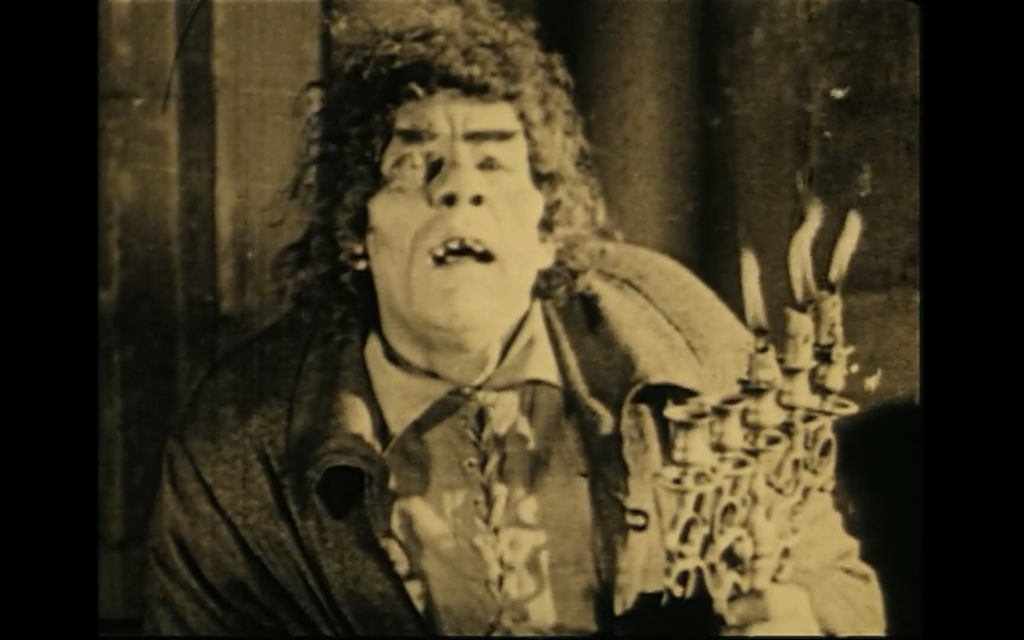 [ Though not a favorite of mine, per se, this is now my third time watching this film, and I definitely enjoy it more with each viewing. thwhtguardian is so right to suggest that this is more a historical fiction film than a horror, and yet it was the foundation upon which the Golden Age of horror films was built, generating high interest in stories about deformed "monsters" (Phantom of the Opera and The Man Who Laughs would follow before Universal transitioned into telling truly supernatural stories with Dracula and Frankenstein), and also proving to American producers and theater-goers alike that horror films could be both heavily stylized and heavily profitable. What I love about the film is how expansive it is. Director Wallace Worsley does a surprisingly adequate job of translating such a complex and multi-faceted novel to the screen, even in spite of censorship issues (you can't have the priest be the bad guy) and the sheer number of characters involved. But beyond that, every set and shot suggests a larger 15th Century Paris just beyond the boundaries of the camera. The sets are astounding in their scope and detail, as is the extensive horde of extras used, and the camera uses them brilliantly so that it's impossible to look at the settings and people and imagine them being anything other then authentic. Some of you have praised the acting in this film. There's no doubt that the lead actors are all highly capable and work in some impressive nuances whenever possible, but they're directed to be overly simplistic, over the top, and hammy. This seems indicative of many American films of the period, while, in contrast, their European counterparts were full of deeply dramatic subtlety and expression. I don't think Universal really begins to develop its full flavor until the influx of German directors and cinematographers in the 1930s. What Fritz Lang, F.W. Murnau, or Karl Freund could have done for this film! Really, the only character who I felt was done justice on the screen was that of Gudule, the once wealthy mother who has grown twisted in self-imposed isolation after losing her young child to gypsy kidnappers. Though her story arc drops off abruptly in the film, Gladys Brockwell brings such sensational energy to it that she utterly steals the spotlight: 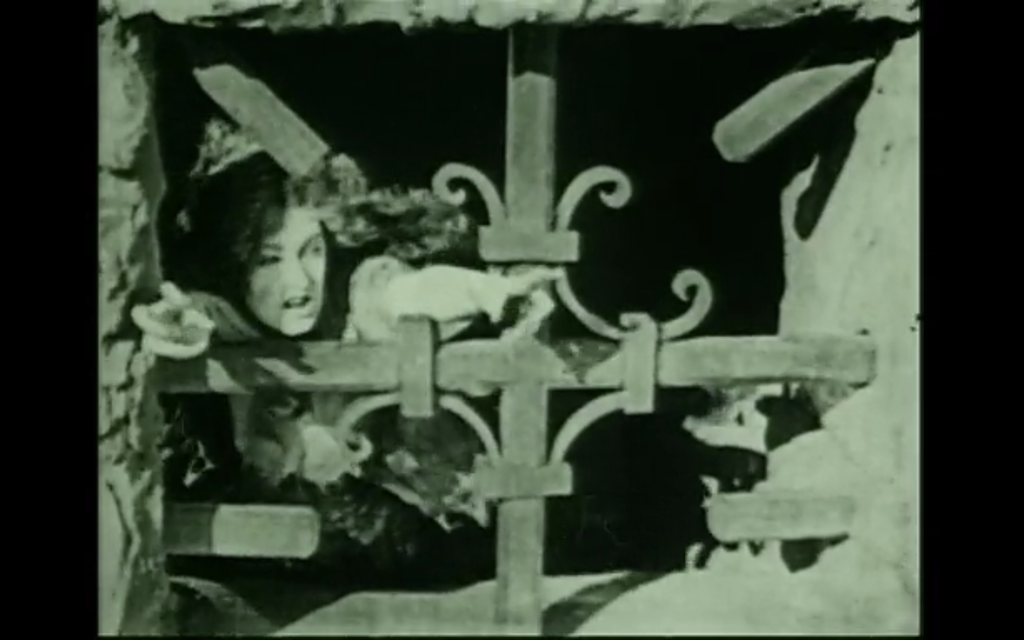 A flawed but rich film, and a critical stepping stone on the path to Golden Age horror perfection.
|
|
|
|
Post by Hoosier X on Jul 6, 2015 12:33:34 GMT -5
Skip Dracula's Daughter and watch Mark of the Vampire instead. It's a better sequel to Dracula, starring Bela Lugosi and directed again by Tod Browning. The only problem with the film is the terrible terrible ending. In fact, Dracula's Daughter was a shameless rip-off of the basic premise of Mark of the Vampire. I've seen Mark of the Vampire and the sort of reconstructed London After Midnight but from what I've read about Dracula's Daughter the plot doesn't sound very similar and I've heard Gloria Holden's performance rivals Lugosi's so I'm pretty interested in it. I liked Dracula's Daughter the first time I saw it. After I saw it a few more times, I realized it would never be one of the movies that I watch every October when my Halloween movie cycle starts.
But I think it has a lot going for it. (Plus it's only 70 minutes!)
In addition to the elements already mentioned, I find it kind of amusing that the actress Marguerite Churchill looks like Mia Farrow.
Please let us know what you think of it when you see it!
|
|
|
|
Post by thwhtguardian on Jul 6, 2015 15:14:02 GMT -5
I've seen Mark of the Vampire and the sort of reconstructed London After Midnight but from what I've read about Dracula's Daughter the plot doesn't sound very similar and I've heard Gloria Holden's performance rivals Lugosi's so I'm pretty interested in it. The premise was the rip-off, not the plot; specifically, Dracula having a daughter. Mark of the Vampire did it first and better, and Dracula's Daughter attempted to follow suit based upon the success of Mark, only without Lugosi in the role of Dracula to accompany her. Eh, that seems a bit weak to me especially as in Mallory's "Universal Studio's Monsters" he writes about how Dracula's daughter first started off as a B-reel adaptation of Dracula's Guest to be shown with future showings of Dracula before taking on its own life as a sequel, and while Stoker's short tale didn't include his daughter it did have a female vampire that they turned into Dracula's daughter in the adaptation. If we're going to say the premise is a rip off I'd say it took more from Joseph Sheridan Le Fanu's "Carmilla" than Mark of the Vampire with their shared aspect of lesbian eroticism. Which reminds me, I should dig out Vapyr which more directly adapts Carmilla. |
|
shaxper
CCF Site Custodian
Posts: 22,871
|
Post by shaxper on Jul 6, 2015 16:33:20 GMT -5
The premise was the rip-off, not the plot; specifically, Dracula having a daughter. Mark of the Vampire did it first and better, and Dracula's Daughter attempted to follow suit based upon the success of Mark, only without Lugosi in the role of Dracula to accompany her. Eh, that seems a bit weak to me especially as in Mallory's "Universal Studio's Monsters" he writes about how Dracula's daughter first started off as a B-reel adaptation of Dracula's Guest to be shown with future showings of Dracula before taking on its own life as a sequel, and while Stoker's short tale didn't include his daughter it did have a female vampire that they turned into Dracula's daughter in the adaptation. If we're going to say the premise is a rip off I'd say it took more from Joseph Sheridan Le Fanu's "Carmilla" than Mark of the Vampire with their shared aspect of lesbian eroticism. 1935: Mark of the Vampire is released and widely considered the unofficial sequel to Browning's Dracula, the most memorable aspect being the vampire's bewitching vampire daughter. 1936: Universal releases an official sequel about Dracula's vampire daughter. Just saying... GREAT film. Doesn't fit the tone of the Universal monster films from my standpoint, but my definition is extremely amorphous and intended only for me  |
|
|
|
Post by thwhtguardian on Jul 6, 2015 16:52:24 GMT -5
Eh, that seems a bit weak to me especially as in Mallory's "Universal Studio's Monsters" he writes about how Dracula's daughter first started off as a B-reel adaptation of Dracula's Guest to be shown with future showings of Dracula before taking on its own life as a sequel, and while Stoker's short tale didn't include his daughter it did have a female vampire that they turned into Dracula's daughter in the adaptation. If we're going to say the premise is a rip off I'd say it took more from Joseph Sheridan Le Fanu's "Carmilla" than Mark of the Vampire with their shared aspect of lesbian eroticism. 1935: Mark of the Vampire is released and widely considered the unofficial sequel to Browning's Dracula, the most memorable aspect being the vampire's bewitching vampire daughter. 1936: Universal releases an official sequel about Dracula's vampire daughter. Just saying... GREAT film. Doesn't fit the tone of the Universal monster films from my standpoint, but my definition is extremely amorphous and intended only for me  That popularity may be the reason it went from a short feature to a full feature, but the idea of a vampire having a daughter just seems like a part of the genre. For my tastes I'm going to consider any monster film that was either put out bt Universal or has a similar mood as fair game unless you'd rather a more specific definition. |
|
shaxper
CCF Site Custodian
Posts: 22,871
|
Post by shaxper on Jul 6, 2015 17:19:54 GMT -5
Nah. Go with what's in your heart  |
|
shaxper
CCF Site Custodian
Posts: 22,871
|
Post by shaxper on Jul 7, 2015 14:02:11 GMT -5
The Phantom of the Opera (1925)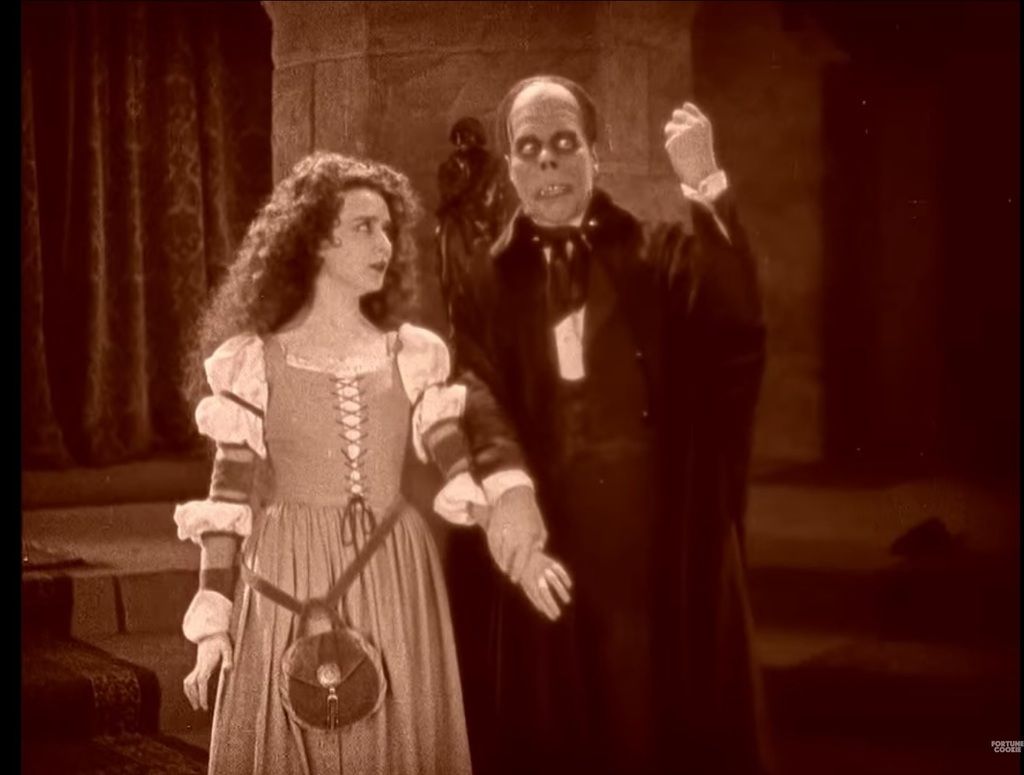 Another film that I enjoy more upon repeated viewings. Whereas I really disliked this film the first time around and felt it was overrated, it's now slowly becoming a favorite of mine. There are significant problems with the film, the most glaring being Mary Philbin who, while drop dead gorgeous, is a terrible actor and utterly ruins many of the scenes she is in. But this film is great on so many other levels. Whereas Hunchback was the first film to sell American filmmakers and audiences on grand, big budget, stylized horror, Phantom is the first to borrow from the dark expressionistic feel of the German horror films of the period, utilizing it in its lighting, shadow play, and even the gothic settings. It's not an expressionistic film, per se: It's more grounded, an Americanized version of German cinematic expressionism. In essence, it's the tone that will subsequently pervade the Universal monster films and most of their contemporaries. And man, those settings. I want my own Phantom Lair: 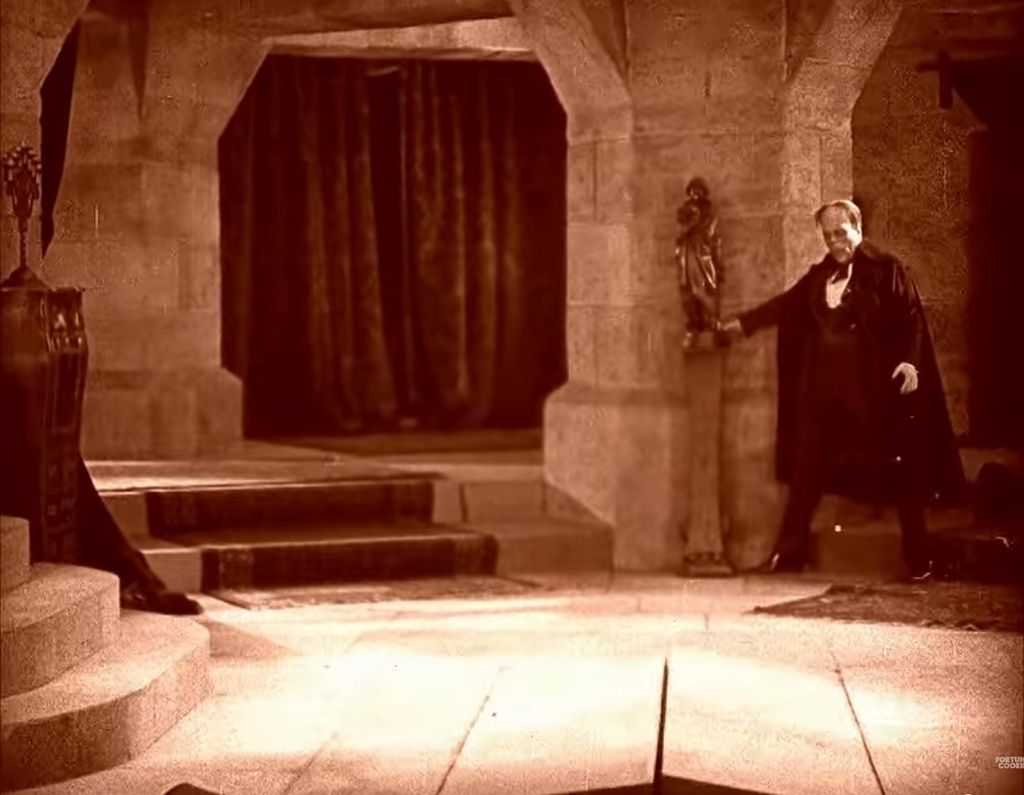 The story is engaging, the acting mostly strong, the visuals stunning, and Chaney's make-up...wow. Definitely watch the restored version I linked to above. The original tinting (and, in one scene, hand-coloring) restored for this version is also a cut above. Universal threw everything at this one; it shouldn't be watched on a budget copy.
|
|
shaxper
CCF Site Custodian
Posts: 22,871
|
Post by shaxper on Jul 7, 2015 14:10:22 GMT -5
London After Midnight (TCM restored cut, 1927) Though I've known about London After Midnight for a long time now, this was my first time watching the "restored" version TCM created, made up of still photographs and the original script. It's hard to truly appreciate a film you've never actually seen. Lost are most of Tod Browning's directoral decisions and the nuances of the actors. As a story, well, it's Mark of the Vampire, with only minor cosmetic differences, but it comes off a little more believable by the close than Mark did. I can't say I really enjoyed this, and it's hard to say how much of that is due to the film and how much to not being able to watch it as it was originally intended. I do think this film was an unusual choice from a rival studio when Universal was experiencing such success with big budget historical horrors featuring actual deformed monsters (albeit with human souls). This film is both more ambitious in appearing to involve murderous vampires and also far more traditional in sticking with an Old Dark House premise, modern setting, smaller budget, and the reveal at the end that there was no true supernatural agent at work. Had I seen this film before, I probably would have skipped it this month, feeling it doesn't really fit the tone of the Universal Monster films. I guess people remember this film because of Chaney's makeup and because its lost. Maybe there's a reason no one bothered to save this one.
|
|
|
|
Post by Prince Hal on Jul 7, 2015 15:43:44 GMT -5
Shax wrote: "I guess people remember this film because of Chaney's makeup and because its lost. Maybe there's a reason no one bothered to save this one."
I remember reading, and more knowledgeable fans than I may correct me, but that to achieve that skull-like look to his eyes, Chaney inserted some kind of wire hook above and below each of his eyes to widen them. Must have been very painful.
|
|
|
|
Post by thwhtguardian on Jul 7, 2015 15:50:39 GMT -5
Shax wrote: "I guess people remember this film because of Chaney's makeup and because its lost. Maybe there's a reason no one bothered to save this one." I remember reading, and more knowledgeable fans than I may correct me, but that to achieve that skull-like look to his eyes, Chaney inserted some kind of wire hook above and below each of his eyes to widen them. Must have been very painful. I've read(In I think "A Man with a Thousand Faces") that it was a kind of glass-less monocle that he wore in each eye to get that skull kind of look, but yeah either way it must have been damn uncomfortable. As for my view on London After Midnight I have to agree with Shax in that I find it confusing that they didn't just make it an actual vampire. I've read that their reasoning was that they didn't think people would take that seriously, which seems odd to me. I will say however that even though we don't get the whole feel of the movie due to the last print having been destroyed by the 1967 MGM fire I still like it better than Mark of the Vampire as I love Chaney's creature effects and the idea of the detective doubling as the vampire is more interesting to me than hiring two people to be vampires as they did in Mark of the Vampire. |
|
|
|
Post by thwhtguardian on Jul 7, 2015 16:17:15 GMT -5
The Hunchback of Notre Dame 1939 RKO  As much as I loved Chaney's creature effects in the original film, I really love the more understated and naturalistic look that Charles Laughton wears here, it's almost as if he's not wearing any prosthetics at all. On top of that this film has the added feature of sound, now I love silent films but the soul that Laughton is able to bring to Quasimodo with his voice is amazing, it's equal parts tortured, mad and at the same time full of a child like innocence which gives us a much deeper look at the nature of the character than a physical performance alone could ever hope to give. On top of that once again we're given these huge, lavish sets that just defy the imagination, but I guess coming from the same company that gave us Kong that is to be expected. |
|
|
|
Post by Deleted on Jul 7, 2015 16:33:27 GMT -5
Charles Laughton was SENSATIONAL and that movie that shared today was right on the money thwhtguardian! Laughton, put so much pride in his role. The two movies that Shax posted here are so memorable in so many ways more than one - I'm equally torn apart of which one is the best. Thanks for sharing them ... I just loved these three movies and I often tried to see them more than once.
|
|
shaxper
CCF Site Custodian
Posts: 22,871
|
Post by shaxper on Jul 7, 2015 17:19:52 GMT -5
As for my view on London After Midnight I have to agree with Shax in that I find it confusing that they didn't just make it an actual vampire. I've read that their reasoning was that they didn't think people would take that seriously, which seems odd to me. That was a major concern in American cinema at the time, and also likely the reason why no film in the 1920s featured an actual supernatural presence. It was always revealed to be the work of man, or (in the case of Hunchback and Phantom) a human who was simply physically disfigured. I always find the warning at the beginning of Frankenstein (1931) fascinating because, while it's partially tongue and cheek, I think there was a real concern there as well. Agreed about how the story holds up. The plot is Mark of the Vampire's one weakness. Beyond that, it's one of the most visually gorgeous films of the Golden Age of Horror and, in some respects, Browning's masterpiece. I can never get over that moment where Luna descends from the air on giant animated bat wings. That does so much more for me than Cheney's makeup in LAM. Though, to be fair, the general consensus is on your side in this debate. |
|
|
|
Post by thwhtguardian on Jul 7, 2015 19:18:52 GMT -5
Murders in the Rue Morgue 1932 Universal 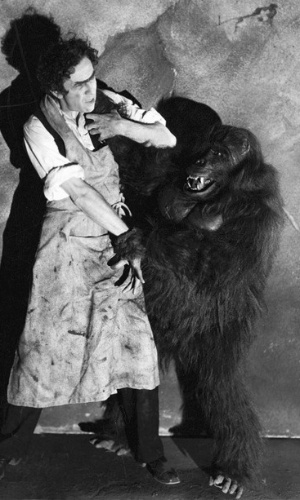 I doubt very much that Edgar Allen Poe would understand why this film ad his short story would bare the same title as the film that shares the same name as Poe's classic exercises all other relevant plot points and characterizations, keeping only the characters names and the Ape itself. Further instead of a serious murder mystery film turned into a horror film which is what I assumed it might be based on it's pedigree it's actually almost more like an off beat romantic comedy with a little horror thrown in. The acting is really hammy and the sets don't match those of Frankenstein or Dracula but it does have a few moments that capture that same eerie mood, namely the shadow play of Lugosi injecting his first victim and image of the ape clambering over the Paris roofs with the unconscious Camille in his clutches...but other wise this was a miss for me. |
|